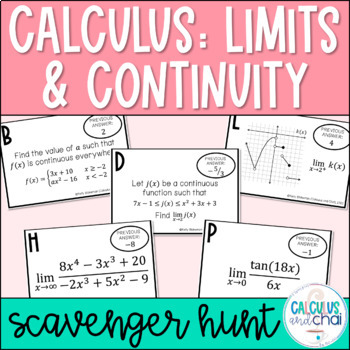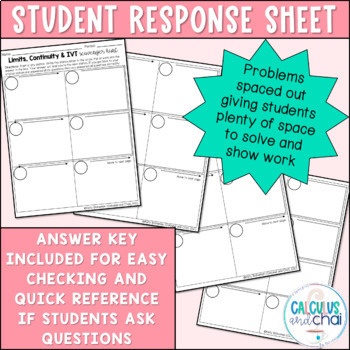Limits and Continuity Review
- Zip
What educators are saying
Description
Limits and Continuity Review Scavenger Hunt is a fun and interactive way for students to work on calculus limits and continuity practice exercises. This activity gets students out of their seats and moving around the room! Scavenger hunts can be completed as individual, partner or small group activity.
The limits and continuity review scavenger hunt has 26 problems that include a variety of different limit, continuity and intermediate value theorem questions. This activity is designed to have students rotate between different concepts; allowing students to work through a variety of questions, even if they do not finish all 26 problems.
Topics Include:
- Computing Limits Algebraically (direct substitution, factoring, conjugates)
- Trigonometry Limits
- Limits at Infinity
- Infinite Limits
- Properties of Limits
- Evaluating Limits Using Graphs (one-sided limits and two-sided limits)
- Continuity
- Types of Discontinuities
- The Sandwich Theorem or Squeeze Theorem
- Intermediate Value Theorem (IVT)
This activity was designed for students that have NOT learned L’Hospital’s Rule but could be a used again later on in the year once students have learned L'Hopital's Rule for additional practice and review of older concepts.
This product includes 26 questions, student response sheet, answer key, and a FULL TYPED SOLUTION KEY.
On the student response sheet problems are spaced out giving students plenty of space to solve and show work. Total of 4 pages for the student response sheet but can be printed doubled sided to save paper.
The answer key is also included for easy checking and quick reference if students ask questions or want to double check their progress.
The FULL typed solution key has a detailed solution for each problem and includes extra commentary on some conceptually challenging problems to help with student understanding.
You may also like:
- Continuity of Functions Task Cards
- Calculus Limit Review Task Cards
- Finding Limits From Graphs Task Cards
- FREE ACTIVITY: Evaluating Limits Using Graphs Printable & Digital Maze
- Calculus Derivative Practice Task Card Bundle
- Derivatives No Chain Rule Scavenger Hunt
- Derivatives Chain Rule Scavenger Hunt
Terms of Use:
This product should only be used by the teacher who purchased it. This product is not to be shared with other teachers. Please buy the correct number of licenses if this is to be used by more than one teacher. A complete terms of use is included in the product.
TpT Store Credits:
You can receive TpT store credits to use on future purchases by leaving feedback on products you buy! Just click on “My Purchases” under “Buy”.
If you have any questions please contact me by email at calculusandchai@gmail.com
Thank you for shopping in my store!
Kelly Blakeman





